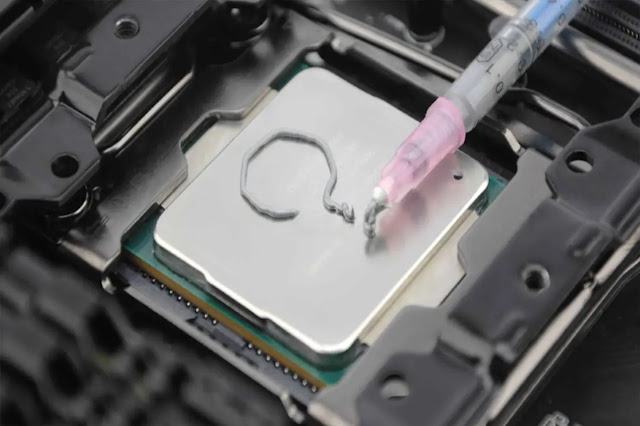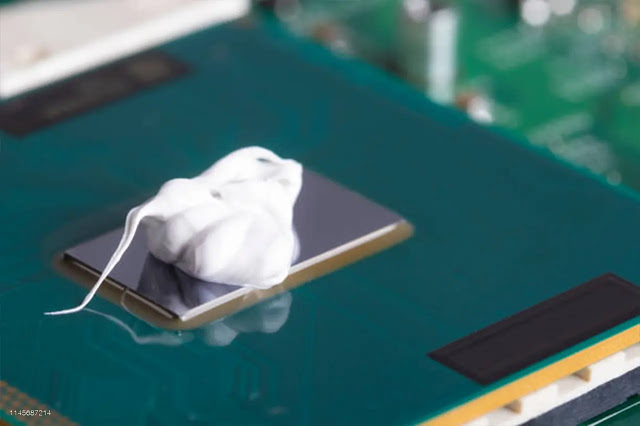If you are new to the world of
computers and hardware or even about to build and assemble a computer yourself,
you should know a very important point about the thermal paste material that we
add on top of the surface of the central processor: Thermal paste is not
intended to cool the central processor in the literal sense, but rather You can
consider it as a material to insulate the metallic layers in contact with each
other because it is what causes the temperatures to rise. Without thermal
paste, the heat sink base will cause the CPU surface temperature to increase
and rise exponentially. But there is another reason why we have to use it and
we will explain it shortly.
What is thermal paste?
We use thermal paste between the
metallic contact surfaces, between the surface of the CPU and the heat sink
base or water pump base in water cooling, in order to improve how high
temperatures are dissipated.
The real idea of using the paste
material came due to the unevenness of the contacting metal surfaces as a
result of the presence of scratches and surface defects that cause air to be
trapped. and air spaces. Air is known to be one of the worst thermal conductors
on Earth, and so it is the actual cause and number one obstacle to dispersal in
dissipating high temperatures efficiently and effectively.
Without thermal paste, the CPU will
operate under high temperatures, from 20°C to 30°C minimum, especially during
heavy workloads and loads on the processor. The purpose of the putty material
is therefore to fill in the gaps and fill in the fine voids and air pockets
between metallic contact surfaces to allow for better and more efficient heat
dissipation. But what about the different types of thermal paste materials?
Types of thermal paste
Gray thermal
paste
Gray paste
material contains solid aluminum or silver metal particles, which makes it one
of the best heat dissipation materials for CPU. This material is able to
dissipate heat better than the white ceramic material at an average of 5 to 6
degrees, but this does not make it the best material used in dissipating heat
in all respects, it also has many negative aspects, the most important of which
is that it is a conductor of electricity, which means That if it is
inadvertently spilled on the pins of the central processor or motherboard
components, it will cause a short circuit or damage the components. Another
downside to them is that they are quite expensive compared to other heat
dissipation materials.
So if you
want to know why Arctic Silver 5 is the most expensive and best selling CPU
thermal paste on Amazon, the reason is that Arctic says it does not damage
hardware and is not electrically conductive even though it contains solids of
aluminum and silver.
But the only
downside is that it may take a full 200 hours after adding it to achieve the
best possible results in CPU cooling, meaning that you will not get the best
result once it is added, but you need to look after 200 hours of adding it and
you will find the best result for it. So in the end, if you're looking for the
best thermal paste material for your CPU or GPU, you won't find it better than
Arctic Silver 5.
white thermal
paste
White thermal
paste materials, which sometimes tend to a light gray color, are made of
ceramic powder containing aluminum oxide and zinc oxide. But cheap and popular
materials from it may contain silicon dioxide. Ceramic thermal paste materials
are not electrically conductive, and they are completely safe even if their
parts are scattered over all parts and parts of the motherboard, there is no
risk of electrical damage because of them,
If you do
spill it on any part of the motherboard, all you have to do is gently remove it
from the surfaces and metal strips, and all your components will work normally
again afterwards, which is exactly the opposite of what happens with gray
thermal paste materials - spilling it means the part is damaged Especially the
metal brackets for socket slots for RAM or processor pins.
And while the
white ceramic putty is completely safe, it's not that expensive either, but
some may be, like Cooler Master High Performance which has the ability to
deliver results quite similar to Arctic Silver 5 - a difference of barely 2
degrees max. However, it is cheaper.
Carbon
Thermal Paste
Most of the
cooler manufacturers claim that carbon-based paste is the best thermal paste
material for cooling computer processors on the planet, and for this reason it
is the most expensive cooling material used for heat dissipation, as it is
safe, reliable, electrically insulating, and at the same time able to dissipate
heat efficiently. High.
Mostly it is
able to provide the same experience and results that you can get from gray
mineral coolers, a difference of barely 1 to 2 degrees max on average in its
favour. Arctic Cooling MX-4 is one of the most popular carbon-based cooling
materials and offers results exactly the same as those of Arctic Silver 5, and
one of its most important advantages is that adding one of it is able to last
for 8 continuous years before it needs to be replaced, which is exceptional
because we need to replace materials Putty every two to three years maximum.
How to properly add thermal paste to the processor
There are
many technical ways to add thermal paste to the processor, but it should be
noted that most of these methods usually require applying a lot of thermal
paste to the surface of the processor. This will lead to the formation of an
excessively thick layer of putty, and when this occurs; Heat will not be
transferred efficiently - the layer may expand and escape to the motherboard,
and if the paste is conductive type, there will be many problems here such as
the whole motherboard being damaged. And even if it's a non-conductive type,
you definitely don't want to add putty that much.
The first
step you must do is to turn off the computer permanently by pressing and
holding the Power button for 10 seconds until the computer shuts down. After
that, remove the wires connected to the case or the battery if you are using a
laptop. Then remove the screws for the fan and gently remove them from the top
of the processor.
If it's been
a long time since you bought your computer or the last time you cleaned the
machine, you'll find that the old thermal paste is stuck hard to the surface of
the processor. Therefore, you should completely wipe off any traces of this old
paste. You can do this using a cotton swab that is usually used to clean the
ear, or using a certain thermal paste cleaner or using isopropyl alcohol. And
it cleans not only the paste from the surface of the processor - but also the
base of the heat sink.
Now, put a
small amount in the middle of the surface of the processor, then place the heat
sink directly above the surface and install and secure it via screws, then
connect the wires and turn on the computer.
The idea
behind using this method is to ensure that a thin layer of paste is applied to
the processor so that it does not spread out when the heat sink is applied.
Other methods of drawing an X or a vertical line and spreading it with a brush
by hand, a credit card or your finger are not recommended and will result in a
lack of heat transfer.
Anyway, after
adding the new thermal paste and turning on the computer, monitor the processor
temperature using the free Speccy software. Note that the temperature may be a
little high for a short time due to the interruption, but it should gradually
decrease after a few hours. If the temperature does not drop after a long
period of time, this may be due to adding too much thermal paste, adding too
little, or because the heat sink is not positioned correctly, or it may be
because it is not clean.
It's a good
idea to monitor your processor's temperature with Speccy, as when you notice a
drop in performance coupled with a high temperature, it might be time to add a
new thermal paste. All in all, thermal paste should last you for years, or
maybe months if you play a lot of video games on your computer or overclock
your processor.
Changing the thermal paste is important to keep your computer and processor at an optimum temperature, and this ensures smooth performance.





.webp)
.webp)
.webp)
.webp)